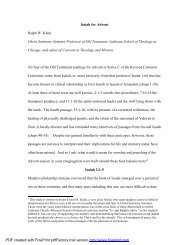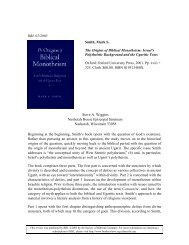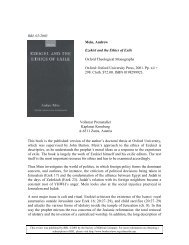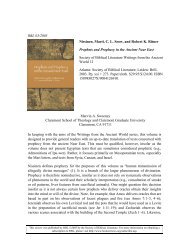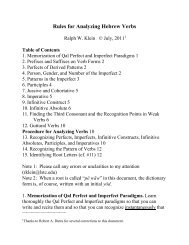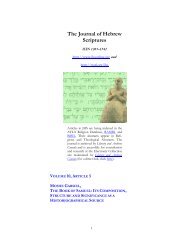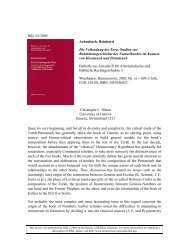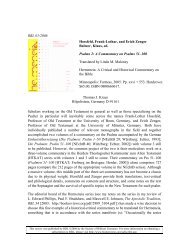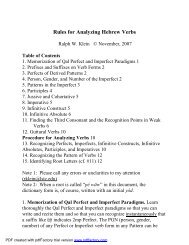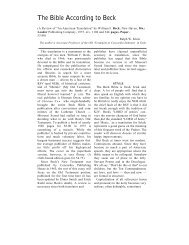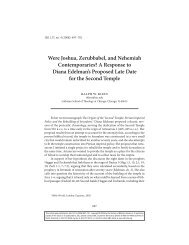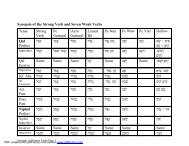could saul rule forever? a new look at 1 samuel 13:13-14
could saul rule forever? a new look at 1 samuel 13:13-14
could saul rule forever? a new look at 1 samuel 13:13-14
Create successful ePaper yourself
Turn your PDF publications into a flip-book with our unique Google optimized e-Paper software.
“nothing indic<strong>at</strong>es th<strong>at</strong> the idea of an eternal dynasty was limited to<br />
either an early or a l<strong>at</strong>e period.” <strong>14</strong><br />
(d) The argument th<strong>at</strong> vv. <strong>13</strong>-<strong>14</strong> in 1 Samuel <strong>13</strong> are<br />
deuteronomistic (on the basis of the appearance of the eternal<br />
dynasty motif in 2 Samuel 7) seems like a circular argument: if 2<br />
Samuel 7 is l<strong>at</strong>e, 15 than 1 Samuel <strong>13</strong>, who alludes to it, must be l<strong>at</strong>e<br />
too. Space limit does not allow me to discuss N<strong>at</strong>han’s oracle in<br />
depth here, and therefore I will summarize briefly my views<br />
regarding the d<strong>at</strong>e and composition of 2 Samuel 7. Scholars who<br />
view N<strong>at</strong>han’s oracle as a l<strong>at</strong>e composition, do it on the basis of the<br />
differenti<strong>at</strong>ion between conditional and unconditional covenants.<br />
According to their view, unconditional covenant is regarded as<br />
belonging to an early d<strong>at</strong>e, while the conditional reformul<strong>at</strong>ion is<br />
assigned to the hands of l<strong>at</strong>er (post exilic) editors. 16 However, this<br />
differenti<strong>at</strong>ion was contested by several scholars, most recently by<br />
<strong>14</strong> L<strong>at</strong>to, “Second Samuel 7,” 263. Cf. G. Beckman, “Royal Ideology<br />
and St<strong>at</strong>e Administr<strong>at</strong>ion in Hittite An<strong>at</strong>olia,” in Civiliz<strong>at</strong>ions of the Ancient<br />
Near East, ed. J. Sasson et al. (New York: Scribner, 1995), Vol. I, 533: “In<br />
most societies of the ancient Near East, kingship was normally passed<br />
from f<strong>at</strong>her to son.”<br />
15 For a review of the various suggestions concerning the redactional<br />
layers in 2 Samuel 7, see Dietrich, W. and T. Naumann, Die Samuelbücher<br />
(Erträge der Forschung, 287; Darmstadt: Wissenschaftliche<br />
Buchgesellschaft, 1995), 153-56.<br />
16 See M. Weinfeld, “The Covenant of Grant in the Old Testament<br />
and in the Ancient Near East,” JAOS 90 (1970), 184-203. For a list of<br />
scholars following Weinfeld’s argument, see J.D. Levenson, “The Davidic<br />
Covenant and Its Modern Interpreters”, CBQ 41 (1979), 205-19. For a<br />
critique of Weinfeld see G.N. Knoppers, “Ancient Near Eastern Royal<br />
Grants and the Davidic Covenant: A Parallel?,” JAOS 116 (1996), 670-97.<br />
7





